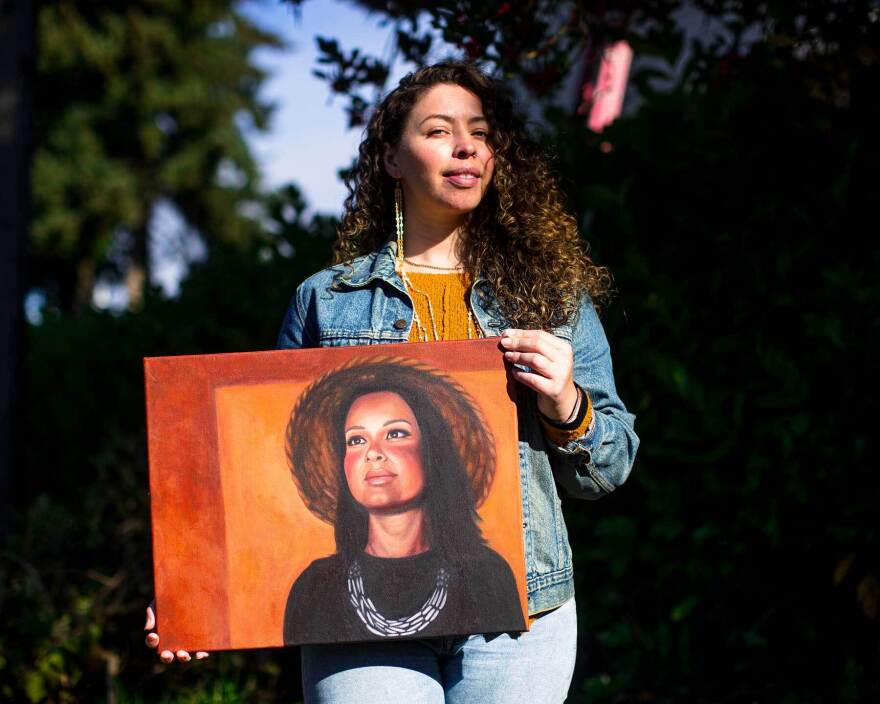Paige Pettibon wants Tacoma to do more — and be more — for artists.
But we’ll get back to that.
Pettibon (Salish and Black) is a multidisciplinary artist, working in mixed media, jewelry design, graphic arts, Lushootseed language and creative writing – and that’s just the beginning. She has an insatiable desire to explore all the facets of her creativity by boldly diving into wildly varied mediums. And she intends to never stop learning more.
She feels fortunate to have had her interest in art wholeheartedly supported by her family and community from an early age. When her parents had time, they enjoyed painting. Both of her grandmothers were artists and creatives who also were influential in her introduction to her own budding creativity. Having two very busy and hardworking parents, art became a constant presence in her life, a tender babysitter, playmate, and teacher in one.
“My parents have always encouraged me to be a creative…they would always have paints and colored pencils ready for me and I could occupy myself anywhere,” Pettibon said.
Pettibon was born and raised in Tacoma, as were her parents. Her maternal grandmother came from a migrant-worker family in Montana, a place, like the Flathead Reservation, for which she continues to hold a strong affection. Her maternal grandfather was a Black man in the Army from Maryland. While visiting Seattle, he happened to run into Pettibon’s great-grandmother, who was so taken with him she introduced him to her daughter. The two were married within two months and settled on the East Side of Tacoma on Portland Avenue, where they raised a family for the rest of their days.

Art, for her, doesn’t exist for its own sake. Art is a conversation, and she has quite a lot to say. But as an artist, speaking comes with a sacred responsibility – listening.
“I don't want to speak on things that I don't know about. And I think that's important. We all don't have to say something just because everyone's saying things…maybe we just need to listen!” she says, laughing. “And sometimes it's just easier to talk through art.”
Pettibon wants people to look closer and listen more carefully when interacting with art. For her, the purpose of art isn’t necessarily to moralize to its audience, but to engage them and have them take away their own meaning, along with all of the personal and historical contexts that people carry with them. Art is tradition and storytelling – and, hopefully, something that approaches traditional storytelling.
For Pettibon, art is something even more. It’s medicine.
She gives the impression that if people were more fluent in the language and power of art, our society might function better. “This time is a time where we can grow and learn and I'm not the kind of person to attack someone for misinformation or misknowledge, but open up a conversation to at least try to see each other's side and try to at least gain some knowledge and some background and some context.”

Pettibon loves how diverse Tacoma is, but laments how culturally and socially segregated it can be, and how disconnected its residents seem to be from the history of the land on which they stand. She references, for instance, how many residents are likely unaware that Tacoma once had a Chinatown, that in 1885 the Chinese population was driven out of town by an angry white mob who burned the community down a few days later. Many residents are likely also unfamiliar with the Puyallup Tribe, its language and its history. These aspects of history and reality greatly impact the culture of the city.
“What can I do to show a little bit of me, show a little bit of history, a little bit of my diverse background and perspective but in a way that Tacoma can receive it? In a way that's respectful, in a way that is curious and understanding, and taking care of this knowledge that I’m sharing with them, or lead them to know another side?”
Although there are several venues in Tacoma that nurture up-and-coming artists – Alma Mater and Fab 5-HQ come to mind – Paige believes there’s a need for many more. This, of course, poses particular challenges during the present COVID era. She imagines online spaces that go beyond social media, that are catered specifically for artists and based on geography, so artists can connect with and be mentored by other local artists and introduced to venues and assets that can often pose too high a barrier of entry.

“I think growing up I didn't have that; I didn't have that knowledge and that history,” she said. “I think it's important for me to use every opportunity I can to gently and gracefully open these doors up for people and I think that's what's really important with what's happening now.”
That perhaps best sums up Paige Pettibon. She feels lucky to have been gifted a community that nurtured her interest in the arts, and as she comes into her own as a working artist – she used to clean houses, babysit and do various odd jobs to support her art – she wants to pay that generosity forward to the youth of Tacoma. She wants there to be many more venues in Tacoma that are diverse and accessible and welcoming to the diverse public, but especially for its young people. A door to the world of creativity and community was opened for her, and she intends to make it much larger for others.
This story is part of the Artists Among Us series of profiles highlighting creatives around the region who are Black, Indigenous and People of Color. Tracy Rector is a mixed-race Choctaw/Black filmmaker, curator, and arts advocate based in Tacoma. She is the managing director of storytelling at Nia Tero and the founder of Indigenous Showcase, an Indigenous media arts organization and home of the nationally acclaimed Longhouse Media.






